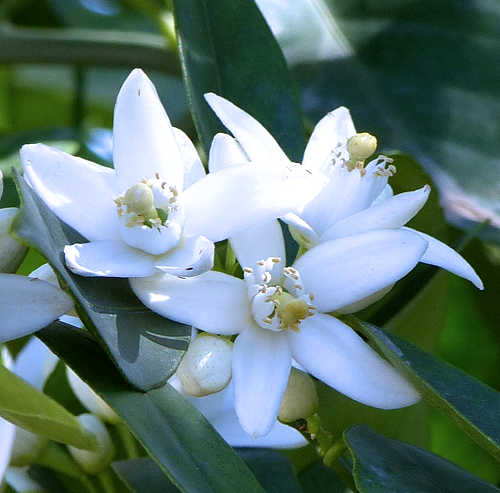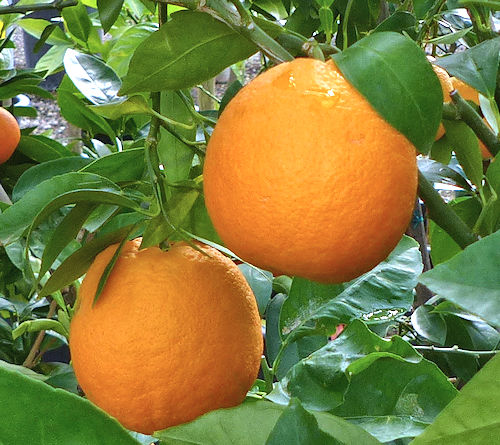Growing Sweet Oranges:
Citrus aurantium
Back to Fruit, Berries and Nuts
Botanical Overview
Members of the Citrus family (Rutaceae), modern Citrus fruits, according to genetic analysis, are complex hybrids arising from mandarin, pomelo, and citron ancestors, refined by more than four thousand years of cultivation. Citrus aurantium, the sweet orange, has hundreds of cultivars.
Description
Form:
Tree.
Lifespan:
50-100 years.
Leaf retention:
Evergreen.
Growth rate:
Slow to moderate, depending on rootstock.
Mature Size:
To 30' (9m) high without a dwarfing rootstock. The width varies with each cultivar.
Flowers:
White, five petals, fragrant.
Bloom:
Late winter into early spring.
Self-fruitful:
All sweet orange cultivars self-pollinate.
Years before fruiting:
5-6 years after grafting, less on some rootstocks. Blood Orange cultivars often start
fruiting 2 years later. Trees grown from seed take 7 years or more.
Fruit:
Round to oval, ripening to yellow or orange. The flesh is juicy and sweet, yellow, orange
or red in color, and divided into 10-14 segments. The skin is tight and difficult to peel
except on Naval oranges which have thick skin. Seedless cultivars are available.
The sweetness of an orange depends on the total amount of sunlight received while on the
tree, nothing else.
Months for fruit to ripen:
9-12. The color of an orange is not a reliable indicator of ripeness. Remove one from the
tree and taste it to determine if the fruit are ready for harvest. Most Naval Oranges
ripen in winter or early spring and should be harvested by the time new flowers begin to
bloom.
Valencia Oranges ripen in late spring and can remain on the tree until September.
Oranges do not ripen further after harvest.
Storage after harvest:
Oranges can last 2-3 months in a refrigerator but must be well ventilated, not in a sealed
container.
Leaves: Green, smooth, thick, ovate to lance-shaped,
providing heavy shade.
Stems:
A few spines may be present. The bark is prone to sunscald if not shaded by leaves,
especially in higher temperatures.
Roots:
These trees are grafted onto rootstock that is used to control the height of the tree
from dwarf, to semi-dwarf, to standard. The part of the tree above the graft, called the
scion, is selected for its desirable fruit. The rootstock is from a hardier species which
commonly has less tasty fruit.
Cultivars of Note:
'Blood Orange' An orange with dark red flesh, and a flavor
that includes raspberry notes among the citrus. The color is most pronounced in cooler weather.
'Cara Cara' A red-fleshed naval orange, with an excellent,
complex flavor. Extra sweet, low in acidity.
'Naval' An orange grown for fresh eating.
'Valencia' An orange with high vitamin C levels primarily
used for juice.
Wildlife:
The flowers attract bees and other pollinating insects. The fruit attracts birds. Mammals may
strip the bark off of young trees, consume fallen fruit, or climb the tree to eat the fruit.
The leaves are a food source for the Giant Swallowtail butterfly caterpillar – see
Pests, below.
Toxic / Danger:
Not to humans. The leaves are toxic to pets.
Origin:
Asia.
Cultivation and Uses
USDA hardiness zones:
9-11. Frost-tender. Best grown on a south- or east-facing slope above valley bottoms in zone 9a.
Chill hours:
None.
Heat tolerant:
Depends on cultivar.
Drought tolerant:
Depends on rootstock. Drought will damage the fruit crop.
Sun:
Full sun.
Planting:
The best time to plant a citrus tree is after the danger of frost is past, in late winter or
early spring.
Place the tree in a sunny location, away from the coldest part of the yard. Do not position the plant next to a frequently watered location, such as grass. Make sure there is enough space for the tree to grow to its full width and height, with clearance to walk around and where overhead lines will not be a problem.
Dig a hole twice as wide as the rootball, with the root crown at 1-2" (2.5-5cm) above ground level. The top roots must extend out from the trunk, just above, and uncovered by, soil. The soil should slope gently downward from the trunk to the drip line.
Place the tree in a sunny location, away from the coldest part of the yard. Do not position the plant next to a frequently watered location, such as grass. Make sure there is enough space for the tree to grow to its full width and height, with clearance to walk around and where overhead lines will not be a problem.
Dig a hole twice as wide as the rootball, with the root crown at 1-2" (2.5-5cm) above ground level. The top roots must extend out from the trunk, just above, and uncovered by, soil. The soil should slope gently downward from the trunk to the drip line.
Soil:
Well draining to prevent root rot. Do not amend the soil when planting. The roots will adjust
to the native soil surrounding the planting hole.
Fertilize:
Apply an organic fertilizer every month or two from mid-February to early October. Alkaline
soils will cause iron deficiency. Apply a citrus micronutrient solution as necessary when
leaves become yellow with green veins, signalling a micronutrient deficiency. Only use
products containing iron in chelated iron form, which is more easily absorbed by the plant.
Avoid chemical fertilizers because they increase salt build-up in the soil.
Do not fertilize after September to keep the plant from producing new growth that will be
harmed by early frost.
Water after becoming established:
Basin irrigate or
deep water for 1.5 hours or more until the water
has reached a 3' (1m) depth. The frequency of irrigation depends on the species, the age of
the tree and the month of the year.
For trees in the ground three years or more, irrigate as follows:
December-February, every 21-30 days; March-April, every 14-21 days; May-June, every 14 days;
July-September, every 10-14 days; October-November, every 14-21 days.
Inward leaf curling, when the leaves are uniformly green, or drooping leaves, are signs of insufficient water. Solid yellow leaves are a sign of overwatering. Water near the drip line, not at the trunk.
Inward leaf curling, when the leaves are uniformly green, or drooping leaves, are signs of insufficient water. Solid yellow leaves are a sign of overwatering. Water near the drip line, not at the trunk.
Mulch:
Apply organic mulch inside the drip line and 8" (21cm) away from the trunk to reduce soil
evaporation and reduce root zone heat and cold stress.
Place a rodent gnaw guard around the trunk at the bottom.
Prune:
Prune only after danger of the last frost is over in late winter or early spring. Flower
buds develop during the winter dormant period, so pruning after the last frost makes it
possible to avoid excess flower removal.
Citrus trees are best grown as shrubs, so that leafy branches protect their entire trunk from direct sun. Only prune the lowest branches if their tips touch the ground. If you prune up from the bottom to expose the trunk, you must paint it with a tree trunk paint to avoid sunscald.
Remove branches that are dead, damaged, diseased, or malformed. Remove any branches growing less than 45° from the vertical because they may split away as they get larger. Remove any new branches that have an angled cross section (malformed) rather than round. These have restricted veins and will not fruit well. Remove any branches growing from below the trunk graft as they occur. These are rootstock branches, not fruiting stock branches, and will produce inferior fruit.
Never prune to restrict the size of a citrus tree. Rootstocks are used to control the size of these trees.
Remove grass and other plants under the canopy that can compete for water and nutrients by hand-pulling, not with tools that can damage roots close to the surface.
Citrus trees are best grown as shrubs, so that leafy branches protect their entire trunk from direct sun. Only prune the lowest branches if their tips touch the ground. If you prune up from the bottom to expose the trunk, you must paint it with a tree trunk paint to avoid sunscald.
Remove branches that are dead, damaged, diseased, or malformed. Remove any branches growing less than 45° from the vertical because they may split away as they get larger. Remove any new branches that have an angled cross section (malformed) rather than round. These have restricted veins and will not fruit well. Remove any branches growing from below the trunk graft as they occur. These are rootstock branches, not fruiting stock branches, and will produce inferior fruit.
Never prune to restrict the size of a citrus tree. Rootstocks are used to control the size of these trees.
Remove grass and other plants under the canopy that can compete for water and nutrients by hand-pulling, not with tools that can damage roots close to the surface.
Litter:
Dropped fruit must be picked up immediately to avoid attracting wild animals.
Propagation:
Cuttings grafted onto disease resistant rootstock adapted to the local climate. Trees grown
from seed are usually true to their parent tree characteristics and will likely have roots
inappropriate to the local soil and climate.
Pests:
The Giant Swallowtail Butterfly caterpillar. This larvae resembles bird poop and has white
and black and/or brown splotches. On a large plant it will cause no harm.
On a small plant, relocate it to a large citrus.
Distorted leaf shapes are a sign of thrips, which do no real damage. Thrips are attracted to plants that are given too much nitrogen or are overwatered.
For other problems, see Citrus: Diseases and Disorders
Distorted leaf shapes are a sign of thrips, which do no real damage. Thrips are attracted to plants that are given too much nitrogen or are overwatered.
For other problems, see Citrus: Diseases and Disorders
Uses:
Edible fruit, ornamental.
Comments
Its scientific synonym is Citrus sinensis.
Do you have additional information or a different experience for these plants that you would like to share? Email info@GardenOracle.com. All contributions are welcome and appreciated.



Latest update: May, 2025
© 2008-2025 by GardenOracle.com

